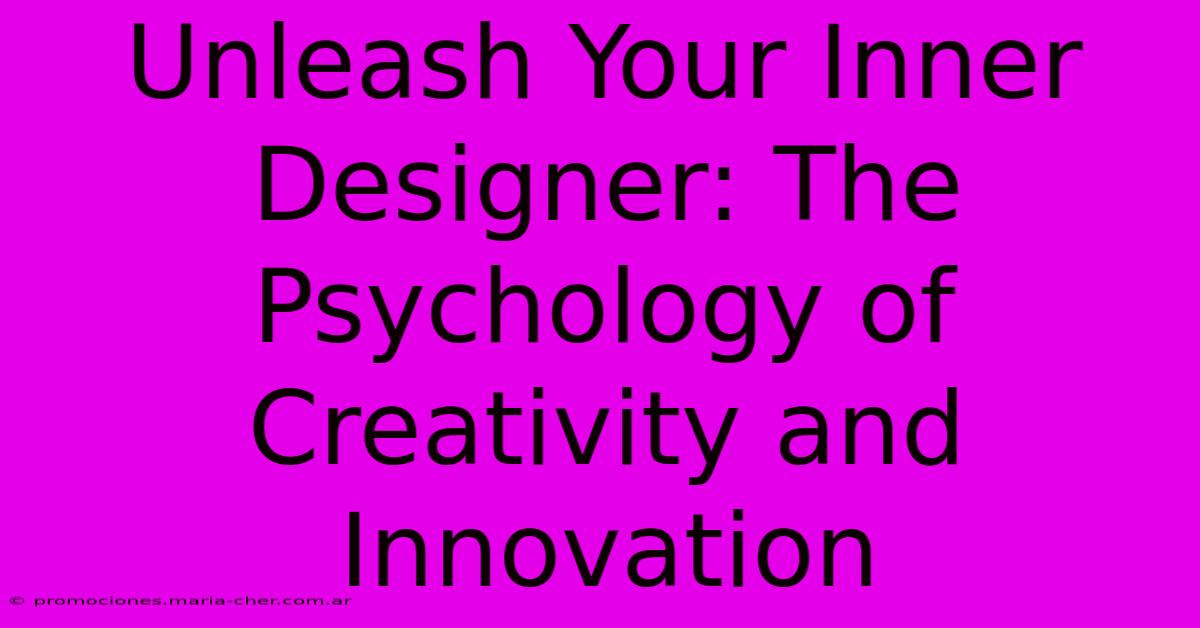Unleash Your Inner Designer: The Psychology Of Creativity And Innovation

Table of Contents
Unleash Your Inner Designer: The Psychology of Creativity and Innovation
Want to unlock your creative potential and become a true innovator? It's not just about talent; it's about understanding the psychology behind creativity. This article delves into the fascinating world of the creative mind, exploring the cognitive processes, psychological factors, and practical strategies that can help you unleash your inner designer and generate groundbreaking ideas.
Understanding the Creative Process: More Than Just Inspiration
The common misconception is that creativity is a sudden burst of inspiration, a "eureka!" moment. While those moments certainly exist, the reality is far more nuanced. The creative process is a complex interplay of different stages:
1. Preparation: Laying the Foundation
This initial phase involves gathering information, exploring different perspectives, and immersing yourself in the problem or challenge at hand. Research, brainstorming, and experiential learning are crucial components of this stage. The more knowledge you have, the richer your creative landscape will be.
2. Incubation: Letting Your Subconscious Work
Once you've gathered sufficient information, it's time to step back and let your subconscious mind do its work. This is the incubation period, where you consciously move away from the problem, allowing your mind to process information and make unexpected connections. Mindfulness, meditation, and engaging in activities unrelated to the project can facilitate this process.
3. Illumination: The "Aha!" Moment
This is the stage where insights emerge, where solutions seemingly appear out of thin air. The "aha!" moment is often preceded by the incubation period and represents a breakthrough in understanding. It's a rewarding stage that highlights the power of unconscious processing.
4. Verification: Refining and Implementing Your Ideas
Finally, you need to refine and test your ideas. This involves evaluating their feasibility, practicality, and potential impact. Iteration, feedback, and experimentation are vital for turning your creative spark into a tangible outcome.
Psychological Factors Influencing Creativity
Several psychological factors significantly impact our creative abilities:
1. Mindset: Embracing a Growth Mindset
A growth mindset, believing that abilities can be developed through dedication and hard work, is crucial for fostering creativity. Individuals with a growth mindset are more likely to embrace challenges, persist in the face of setbacks, and see feedback as an opportunity for improvement.
2. Motivation: Intrinsic vs. Extrinsic
Intrinsic motivation, driven by internal rewards such as satisfaction and enjoyment, is far more effective in fueling creativity than extrinsic motivation, which relies on external rewards like money or praise. When you're genuinely passionate about your work, your creativity naturally flourishes.
3. Emotional Regulation: Managing Stress and Anxiety
High levels of stress and anxiety can stifle creativity. Developing effective stress management techniques, such as mindfulness or exercise, is essential for maintaining a clear and focused mind.
4. Curiosity and Openness to Experience: Exploring New Horizons
Creative individuals are inherently curious and open to new experiences. They actively seek out diverse perspectives, challenge existing assumptions, and are not afraid to step outside their comfort zones.
Practical Strategies to Boost Your Creativity
Several strategies can help you enhance your creative output:
- Brain Dumping: Regularly writing down your thoughts and ideas, no matter how seemingly insignificant.
- Mind Mapping: Visually organizing your thoughts and ideas to make connections and identify patterns.
- Freewriting: Writing continuously for a set period without editing or censoring your thoughts.
- Creative Collaboration: Working with others to generate a wider range of ideas and perspectives.
- Regular Breaks and Downtime: Allowing your mind to rest and recharge.
- Exposure to Stimulating Environments: Surrounding yourself with inspiring people, places, and experiences.
Conclusion: Embrace the Journey
Unleashing your inner designer is an ongoing journey, not a destination. By understanding the psychology of creativity and implementing the strategies outlined above, you can cultivate a creative mindset, overcome obstacles, and consistently generate innovative ideas. Embrace the process, enjoy the journey, and watch your creativity blossom. Remember, the most innovative ideas often arise from unexpected places and unconventional approaches. So, dare to experiment, challenge the status quo, and unlock your full creative potential.

Thank you for visiting our website wich cover about Unleash Your Inner Designer: The Psychology Of Creativity And Innovation. We hope the information provided has been useful to you. Feel free to contact us if you have any questions or need further assistance. See you next time and dont miss to bookmark.
Featured Posts
-
From Snapshots To Showstoppers The Ultimate Guide To Framing Black And White Masterpieces
Feb 08, 2025
-
Maximize Your Decor With The Enchanting Power Of Bulk Dried Babys Breath Create Unforgettable Moments
Feb 08, 2025
-
From Humble Blossoms To Breathtaking Displays The Creative Art Of Garland Making
Feb 08, 2025
-
Bloomtastic Secrets How To Elevate Your Wedding Tablescapes With Flowers
Feb 08, 2025
-
Chill Out With The Coolest Summer Color Palette Beat The Heat With Serenity
Feb 08, 2025
